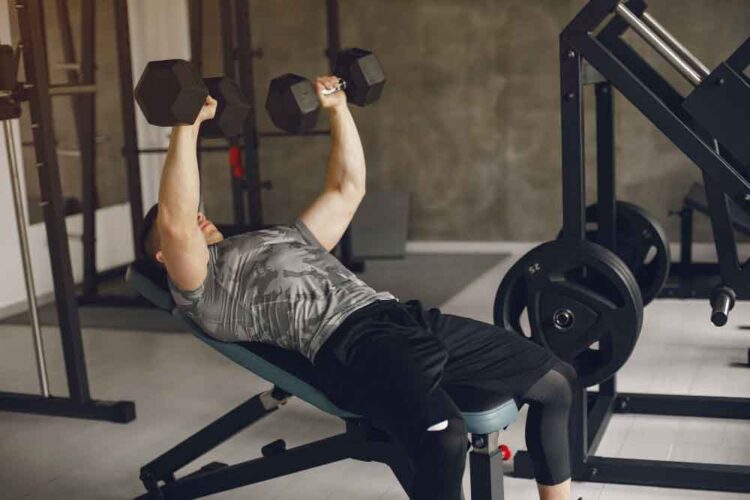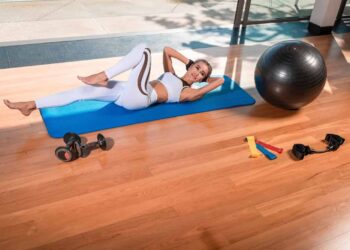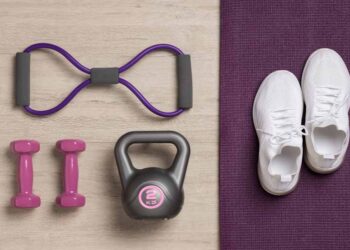Are you looking to take your chest workout to the next level? While bench presses and pushups are popular exercises for targeting the chest, there’s one move that specifically hones in on the adduction of the arms towards the midline of the body – the chest fly. But do you know how to nail the technique and form for maximum results?
Whether you’re a beginner or an experienced lifter, understanding the ins and outs of chest flies can unlock the potential for peak muscle growth and strength gains in your chest. From the classic dumbbell chest fly to variations that can be performed with machines, we’ve got you covered.
In this comprehensive guide, we’ll break down the benefits of the bench dumbbell chest fly, provide detailed instructions on how to perform it with proper form, offer tips for maximizing your results, explore alternatives to minimize the risk of injury, and emphasize the importance of balanced chest training. But first, let’s dive into why mastering chest fly exercises is crucial for your chest workout routine.
Benefits of the Bench Dumbbell Chest Fly
The dumbbell chest fly is an effective exercise for targeting the inner part of the chest, which is often overlooked in pressing movements. By adding chest adduction to your training plan, you can stimulate muscle growth in the chest, specifically targeting the inner chest. This concentrated squeeze can help to develop chest size and strength, providing a balanced and well-rounded chest development. However, it is important to note that the dumbbell chest fly may not be suitable for everyone, and alternatives should be considered to avoid potential risks to the shoulder joints.
When performing the dumbbell chest fly, the arms are brought together in a controlled manner, engaging the chest muscles in a unique way. This movement activates the inner chest muscles, promoting their development and adding definition to the chest. While pressing exercises primarily focus on the pectoralis major, the dumbbell chest fly specifically targets the inner chest, creating a more well-rounded and aesthetic appearance.
The key benefit of the dumbbell chest fly is its ability to isolate the inner part of the chest, which can be challenging to target with traditional pressing movements. By incorporating this exercise into your workout routine, you can achieve a more complete chest development and enhance overall upper body strength.
Additionally, the dumbbell chest fly allows for a greater range of motion compared to other exercises, which can lead to increased muscle activation and growth. The controlled movement of bringing the dumbbells together forces the chest muscles to contract intensely, leading to greater hypertrophy and strength gains.
It is important to note that while the dumbbell chest fly offers numerous benefits, it may not be suitable for everyone. Individuals with pre-existing shoulder or chest injuries should exercise caution or seek alternative exercises to avoid exacerbating their condition. Consulting with a qualified fitness professional or physical therapist can help determine the appropriateness of the dumbbell chest fly based on individual needs and limitations.
It is also crucial to prioritize proper form and technique when performing the dumbbell chest fly. This includes maintaining a neutral spine, engaging the core muscles for stability, and using a weight that allows for controlled movement without sacrificing form. Gradually increasing the weight as strength improves can further enhance the benefits of the exercise.
In summary, the dumbbell chest fly is a valuable exercise for targeting the inner chest, promoting muscle growth, and creating a balanced and well-developed chest. However, it should be performed with caution and alternatives should be considered for individuals with shoulder or chest injuries. When executed correctly, the dumbbell chest fly can be an effective tool in achieving optimal chest development and enhancing upper body strength.
How to Do the Bench Dumbbell Fly
To perform the bench dumbbell fly, follow these steps:
- Lie back on a bench with a dumbbell in each hand, holding them with a neutral grip.
- Press the dumbbells up above your chest, engaging your shoulder blades by driving them back into the bench.
- Keep your feet on the ground and activate your glutes and abs to create full-body tension.
- Adjust your hand position by turning your pinkies toward each other, which helps to create external rotation at the shoulder joints.
- Bend your elbows slightly and lower the weights down to the sides, focusing on moving only at the shoulders.
- Lower the weights to a comfortable range of motion where you feel a stretch in your chest.
- Squeeze your pecs to raise the weights back up to the starting position, focusing on the top squeeze rather than slamming the weights together.
- Continuously maintain tension in your shoulder blades throughout the exercise to protect your shoulders and promote chest contraction.
Proper execution of the bench dumbbell fly involves a controlled movement and maintaining proper form cues. Remember to engage your core and ensure that the movement is coming from your shoulders, not your elbows or wrists. By performing this exercise with proper form, you can effectively target your chest muscles and maximize the benefits of the dumbbell fly.
Tips for Maximizing the Dumbbell Fly
When performing the dumbbell fly exercise, there are several key points to keep in mind in order to maximize your results and achieve optimal chest growth. By following proper form cues and implementing specific techniques, you can enhance your dumbbell fly workout and see significant improvements in your chest development.
1. Focus on Pec Squeeze at the Top
To get the most out of the dumbbell fly, emphasize the squeeze of your pecs at the top of the movement. As your arms come together, concentrate on contracting your chest muscles fully. This deep chest squeeze promotes chest growth and ensures that you are targeting the intended muscle group. Avoid touching the dumbbells at the top, as this eliminates the opportunity for a complete pec squeeze and reduces the effectiveness of the exercise.
2. Maintain a Controlled Range of Motion
While performing the dumbbell fly, it’s important to avoid lowering the weights too deep. The goal is not to overstretch the pecs but rather to work through a natural range of motion. Lower the dumbbells until you feel a stretch in your chest, maintaining control throughout the movement. By staying within a comfortable range, you can effectively target the chest muscles without compromising form or risking injury.
3. Squeeze Shoulder Blades Together
Continuously squeeze your shoulder blades together throughout the entire exercise. This not only protects your shoulders but also ensures full engagement of the chest muscles. By maintaining this squeeze, you challenge the chest to contract fully without compromising the joint space in your shoulders. This technique helps to maximize the effectiveness of the dumbbell fly and promote optimal muscle activation.
4. Prioritize Precision and Control
Take your time with each repetition of the dumbbell fly and prioritize precision and control. Avoid rushing through the movement or using momentum to lift the weights. Instead, focus on a slow and controlled execution, emphasizing the contraction of the chest muscles at the top of each repetition. By maintaining a deliberate and controlled pace, you will get the most out of your dumbbell fly workout and experience enhanced chest development.
| Key Points for Maximizing the Dumbbell Fly |
|---|
| Focus on pec squeeze at the top of the movement |
| Maintain a controlled range of motion |
| Squeeze shoulder blades together |
| Prioritize precision and control |
Alternatives to the Bench Dumbbell Chest Fly
While the dumbbell chest fly can be a beneficial exercise, it may not be the best option for everyone due to the potential risk to the shoulder joints. If you are looking for alternatives that provide a safer and more effective way to work chest adduction into your routine, consider the following exercises:
Cable Flies
Cable flies are a great alternative to the dumbbell fly. By using a cable machine, you can maintain constant tension on the chest muscles throughout the entire range of motion. Start by standing in the center of the cable machine, holding the handles out to your sides. With a slight bend in your elbows, bring your hands together in front of your chest, focusing on squeezing your chest muscles. Slowly return to the starting position and repeat for the desired number of reps.
Single-Arm Cable Crossovers
A single-arm cable crossover is another effective exercise for chest adduction. Set the cable pulleys to the highest position and stand in the center, grasping one handle with each hand. Step forward with one foot and slightly bend your knees. Start with your arms out to your sides and then bring one arm across your body, focusing on squeezing your chest. Return to the starting position and repeat with the other arm. This exercise provides a full range of motion and targets the chest muscles across the midline.
Resistance Band Chest Exercises
If you prefer to work out at home or have limited equipment, resistance bands can be a great alternative for targeting the chest muscles. Anchor the band to a stable surface at chest height and hold the ends of the band in each hand. Step back until you feel tension in the band and then perform movements similar to cable flies or crossovers. Focus on squeezing your chest muscles at the peak of each contraction to maximize the effectiveness of the exercise.
It is important to choose exercises that minimize the risk of injury while effectively targeting the chest muscles. By incorporating these alternatives into your routine, you can still achieve excellent chest development and strength gains without compromising your shoulder joints.
The Importance of Balanced Chest Training
To achieve optimal chest development, it is important to incorporate exercises that target different areas of the chest muscles. The pectoralis major is made up of three parts: the upper chest fibers, mid chest fibers, and lower chest fibers. Each of these areas requires specific exercises to stimulate growth and promote balanced strength development.
By incorporating a variety of exercises into your chest workout plan, you can ensure that all areas of the chest are being targeted effectively. The barbell bench press is a great exercise for overloading the mid chest, while incline bench press targets the upper chest. Weighted dips are effective for overload in the lower chest. By including exercises that work the chest across midline, such as cable crossovers, you can achieve a well-rounded and balanced chest training routine.
Chest Workout Plan
| Exercise | Targeted Area |
|---|---|
| Barbell Bench Press | Mid Chest |
| Incline Bench Press | Upper Chest |
| Weighted Dips | Lower Chest |
| Cable Crossovers | Across Midline |
“A balanced chest training routine involves targeting different areas of the chest muscles to achieve well-rounded development and strength gains.” – Fitness Expert
By incorporating exercises that specifically target the upper, mid, and lower chest, you can ensure that no area is neglected, leading to a more balanced physique. Additionally, working the chest muscles across the midline helps promote balanced growth and prevents muscle imbalances, reducing the risk of injuries.
Remember to adjust the weights and repetitions according to your fitness level and goals. It is also important to prioritize proper form and technique to ensure maximum effectiveness and minimize the risk of injury. Consult with a fitness professional to create a customized chest workout plan that suits your individual needs and goals.
Incorporating a variety of exercises that target different areas of the chest muscles is key to achieving a balanced chest training routine. By focusing on both overall chest development and specific areas, you can enhance muscle growth, strength, and aesthetics. Remember to always listen to your body, prioritize proper form, and adjust your workout plan as needed to continue making progress in your chest training journey.
Chest Workouts with Different Equipment
Chest workouts are an essential part of any fitness routine, and they can be performed using various types of equipment. Whether you have access to a fully-equipped gym or prefer to work out at home, there are effective options available to target your chest muscles.
Gym Workouts:
If you have access to a gym, take advantage of the equipment to perform exercises that can help you build a strong and well-developed chest. The following exercises are recommended:
- Barbell Bench Press: This classic compound movement targets the chest, shoulders, and triceps. It is a staple exercise for building overall chest strength and size.
- Cable Crossovers: This exercise provides constant tension on the chest muscles, promoting muscle growth and definition. It is an effective exercise for targeting the inner chest.
By incorporating these exercises into your gym workouts, you can effectively stimulate your chest muscles, achieve optimal muscle growth, and enhance overall strength.
At-Home Workouts:
If you prefer working out at home or have limited equipment, don’t worry! You can still perform chest exercises that will challenge your muscles and help you achieve your fitness goals. Dumbbell chest workouts and resistance band exercises are great options.
- Dumbbell Chest Workouts: Dumbbells are versatile and accessible, making them perfect for chest workouts at home. Some effective dumbbell exercises for the chest include:
| Exercise | How to Perform |
|---|---|
| Dumbbell Fly | Lie on a bench, holding dumbbells in each hand. Lower the dumbbells out to the sides, maintaining a slight bend in the elbows. Keep your core engaged and squeeze your chest muscles as you bring the dumbbells back up. |
| Incline Dumbbell Press | Set up an incline bench at a slight angle. Hold dumbbells in each hand and press them up above your chest. Lower the dumbbells down to the sides of your chest, and push them back up, focusing on squeezing your chest at the top. |
| Push-Ups | Assume a plank position with your hands slightly wider than shoulder-width apart. Lower your chest to the ground while keeping your body in a straight line. Push yourself back up, focusing on engaging your chest muscles. |
- Resistance Band Chest Workouts: Resistance bands are affordable and versatile training tools that can be used for chest exercises at home. The following exercises can be done using resistance bands:
| Exercise | How to Perform |
|---|---|
| Chest Press | Attach the resistance band to a stable object at chest height. Hold the handles and step away from the attachment point, creating tension. Push your hands forward, extending your arms in front of your chest, and then slowly return to the starting position. |
| Chest Fly | Keep the resistance band attached to a stable object at chest height. Hold the handles and step away from the attachment point, creating tension. Open your arms out to the sides, keeping a slight bend in your elbows. Squeeze your chest muscles as you bring your arms back to the starting position. |
By incorporating these exercises into your at-home workouts, you can effectively target your chest muscles, promote muscle growth, and improve overall chest strength and definition.
Remember, regardless of the equipment you have available, the key to a successful chest workout is maintaining proper form and challenging your muscles. Consistency and progression in your workouts will yield the best results. Combine chest exercises with a well-rounded fitness routine to achieve balanced strength development and overall fitness.
Conclusion
In conclusion, mastering chest fly exercises, whether with dumbbells or machines, can contribute to peak muscle growth and strength gains in the chest muscles. The dumbbell chest fly is particularly effective in targeting the often overlooked inner part of the chest that is not fully activated during pressing movements.
However, it is crucial to understand and prioritize proper form and execution to maximize the benefits of the dumbbell fly while minimizing the risk of injury. By maintaining proper technique, you can ensure safe and effective chest fly exercises that promote muscle development and help you achieve desired results.
If you find the bench dumbbell chest fly unsuitable for your fitness level or if you have concerns about potential shoulder joint risks, there are alternatives available. Consider incorporating exercises such as cable flies or single-arm cable crossovers into your chest workout routine. These exercises provide a safer and equally effective way to target chest adduction and promote muscle growth.
Remember, a well-rounded and balanced chest training routine involves incorporating various exercises that target different areas of the chest. By diversifying your chest workouts and targeting the upper, mid, and lower chest fibers, you can achieve a symmetrical and proportionate chest development. Regardless of the equipment available to you, be it dumbbells, machines, or resistance bands, ensure that you prioritize proper form and technique for safe and effective chest fly exercises.














